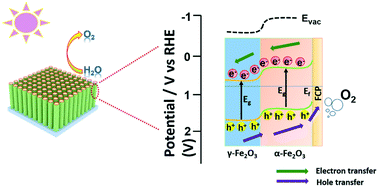Revealing long-lived electron–hole migration in core–shell α/γ-Fe2O3/FCP for efficient photoelectrochemical water oxidation†
Abstract
The oxygen evolution reaction (OER) of Fe2O3 is limited by its low photocarrier separation efficiency in photoelectrochemical (PEC) water splitting. How to construct an effective photocarrier transmission route in Fe2O3 has become an important bottleneck for enhancing OER performance. Herein, we exploit a core–shell nanorod structure loaded with FeCo Prussian blue (FCP) to boost the water oxidation kinetics and charge transfer efficiency for the first time. As expected, the optimal γ-Fe2O3/α-Fe2O3 photoanode exhibits a remarkable photocurrent density of 2.4 mA cm−2 at 1.23 V vs. RHE; when a cocatalyst FCP is introduced as a hole-transport layer, it shows a photocurrent density of 3.5 mA cm−2 at 1.23 V vs. RHE, which is 8.7 times higher than that of the pure α-Fe2O3. The outstanding photochemical performance could be attributed to the highest separation efficiency. A further study on the carrier lifetime was performed and clarified that the photocarrier lifetime of the γ-Fe2O3/α-Fe2O3/FCP photoanode is prolonged (∼50.64 ps) as compared to that of the pure α-Fe2O3 photoanode (∼21.00 ps) using femtosecond time-resolved absorption spectroscopy (fs-TAS). This work successfully explains the photocatalytic water oxidation mechanism in the γ-Fe2O3/α-Fe2O3/FCP photoanode and provides an effective insight into designing a photocarrier delivery channel for the outstanding water oxidation.



 Please wait while we load your content...
Please wait while we load your content...